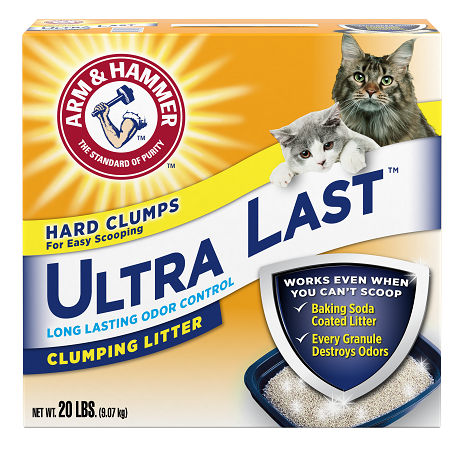What Litter Do Cats Like?
Every cat is different, but as a rule, most cats prefer a cat litter with a soft, sandy texture. This type of litter will behave more like the dirt cats choose outside and the clumping action controls odors that can bother cats’ sensitive noses.
Some cats are pickier than others about their litter and will only use a certain type of litter. One thing we can be sure of though: no cat likes a dirty litter box, so scoop or change your cat’s litter regularly.
How To Tell If a Cat Doesn’t Like Their Litter

If a cat doesn’t like the litter you’ve put in the box, they’re usually not shy about letting you know. If your cat suddenly pooped on the floor for the first time and you’ve changed litters, that’s definitely a sign. Other signs your cat doesn’t like their litter include:
- Refusing to use the litter box or even climb into it
- Scratching at the litter from outside the box (hoping to uncover something different?)
- Perching their paws on the edges of the box to not touch the litter
- Not digging or scratching in the box
- Not covering their poop
- Walking up to the box and then walking away
- Pawing at the floor or walls after using the litter box
- Grooming themselves immediately after using the box, especially for a long time
- Sneezing or coughing while using the litter box
- Pooping or peeing outside the litter box
How to Switch Cat Litters
Cats are creatures of habit and whenever there is a change in their environment or their usual food, treats, litter or routine, they tend to get stressed. Changing litter can be stressful for both kitty and cat parents, but with patience, you both can adjust. You might consider using a pheromone or calming spray if your vet advises it to help your cat get through the stress of the change.
Steps to Transitioning to a New Cat Litter

There are two ways to transition your cat to a new cat litter, depending on whether you’re also trying a new litter box or want to keep the old one. Sometimes it’s best to start fresh with a new box if it’s been a while, to get rid of any lingering smells that can seep into the plastic over time.
On the other hand, there’s something to be said about minimizing change for kitty, too, so you may prefer to change only one thing (litter or box) at a time. You know yourself and kitty best, so choose the method that’s right for the two of you!
Whether you’re switching to a new litter, a new litter box, or both, the transition steps begin with choosing a new litter that cats tend to like and that meets your needs in terms of odor control, weight, tracking, and dust. You can also try a litter with a calming scent built right in, such as ARM & HAMMER™ Forever Fresh Lavender Scented Litter.
New Litter Box Transition Method:
- Buy a second litter box to hold the new litter and keep old litter in the previous litter box.
- Place the new litter and litter box near the current one so kitty can explore.
- Watch your cat’s habits over the next few days. If kitty enters the new box and scratches around, this is a sign they like it! If they poop or pee in it, you’re on your way.
- Gradually stop adding clean litter to the old box and take it away once kitty is using the new one regularly.
- Watch your cat and look for signs of not liking the new litter above and slow down if you need to.
Blend Cat Litter to Transition to a New One Method:
If you’re not changing out the litter box or if you’ve tried Method #1 and kitty is still not using the new litter and box, follow these steps.
- Sprinkling some of the new litter on top of the previous litter.
- As you scoop out clumps, add more of the new litter in each time.
- Get to about 1/3 new litter and 2/3 old litter, mixed together.
- Continue to reduce the old litter until you have exclusively the new litter.
- Watch your cat and look for signs of not liking the new litter above and slow down if you need to.
Reasons to Switch Cat Litters
Even though it may take some time for kitty to get used to a new litter, there can be good reason to switch litters. Here are a few:
- Your vet advises a new litter for your cat’s health.
- Your cat doesn’t use their current litter or shows signs of litter frustration.
- Your cat has a medical need, or their toileting needs change.
- You need a lighter weight cat litter formula that you can lift and carry.
- You get a new cat and need to move to a stronger odor control formula.
- You are dissatisfied with the odor control, tracking, or dust control of your current litter.
- You want to move to a clumping cat litter that is easier to scoop and clean.
- You want to make more sustainable choices with your cat litter or support specific brands.
- You want to try a new litter that has features you appreciate.
Try These Cat Litters When You Need to Switch Litters
ARM & HAMMER™ makes clumping cat litters with the soft texture that cats tend to naturally prefer.
- ARM & HAMMER™ HardBall™ Clumping Cat Litter – this revolutionary plant-based, hard clumping, lightweight formula is reason to switch to get all the benefits for you and kitty.
- ARM & HAMMER™ Slide™ Non-Stick Clumping Cat Litter – for no scrubbing and scraping as you clean the litter box and powerful odor control for multi-cat households.
- ARM & HAMMER™ Forever Fresh Clumping Cat Litter – with calming lavender scent and baking soda to help neutralize odors, plus low tracking and 99% dust-free.



